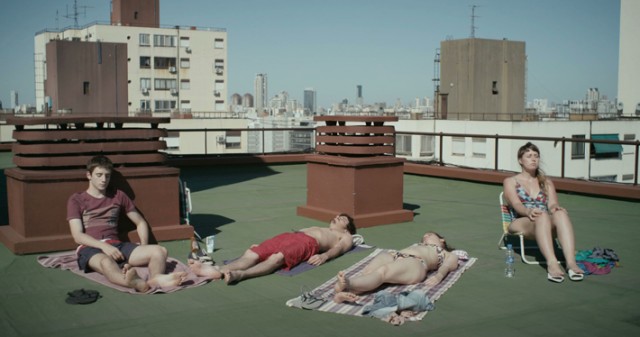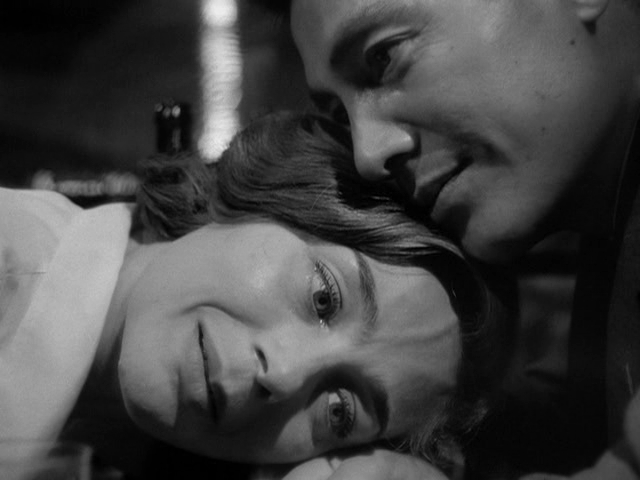
A French actress (Emmanuelle Riva) and a Japanese architect (Eiji Okada) examine their Hiroshima affair in Alain Resnais classic
HIROSHIMA MON AMOUR (Alain Resnais, 1959)
Film Society of Lincoln Center, Elinor Bunin Munroe Film Center, 144 West 65th St., October 17-30, 212-875-5050
Film Forum, 209 West Houston St., October 17-28, 212-727-8110
www.filmforum.org
www.filmlinc.com
 In July 1959, Cahiers du cinéma published a roundtable discussion with Eric Rohmer, Jean-Luc Godard, Jacques Rivette, and others about Alain Resnais’s Hiroshima Mon Amour, in which Rohmer said, “Hiroshima is a film about which you can say everything. . . . Perhaps Hiroshima really is a totally new film. . . . I think that, in a few years, in ten, twenty, or thirty years, we shall know whether Hiroshima was the most important film since the war, the first modern film of sound cinema. . . . In any case it is an extremely important film, but it could be that it will even gain stature with years.” Some four and a half decades later, Rohmer’s prediction has come true, as a stunning new 4K digital restoration reveals Hiroshima Mon Amour to indeed be one of the most important films in the history of cinema, redefining just what the medium is capable of, as fresh and innovative today as it was to Rohmer, Godard, Rivette, et al. upon its initial release. As the black-and-white film opens, two naked, twisted bodies merge together in bed, first covered in glittering ashes, then a kind of acid rain. The woman (Emmanuelle Riva) is a French actress who is in Hiroshima to make a movie about peace. He (Eiji Okada) is a Japanese architect, a builder working in a city that has been laid to waste. Both married with children, they engage in a brief but torrid affair; as her film prepares to wrap, she gets ready to leave, but he begs her to stay. Theirs is a romance that could happen only in Hiroshima.
In July 1959, Cahiers du cinéma published a roundtable discussion with Eric Rohmer, Jean-Luc Godard, Jacques Rivette, and others about Alain Resnais’s Hiroshima Mon Amour, in which Rohmer said, “Hiroshima is a film about which you can say everything. . . . Perhaps Hiroshima really is a totally new film. . . . I think that, in a few years, in ten, twenty, or thirty years, we shall know whether Hiroshima was the most important film since the war, the first modern film of sound cinema. . . . In any case it is an extremely important film, but it could be that it will even gain stature with years.” Some four and a half decades later, Rohmer’s prediction has come true, as a stunning new 4K digital restoration reveals Hiroshima Mon Amour to indeed be one of the most important films in the history of cinema, redefining just what the medium is capable of, as fresh and innovative today as it was to Rohmer, Godard, Rivette, et al. upon its initial release. As the black-and-white film opens, two naked, twisted bodies merge together in bed, first covered in glittering ashes, then a kind of acid rain. The woman (Emmanuelle Riva) is a French actress who is in Hiroshima to make a movie about peace. He (Eiji Okada) is a Japanese architect, a builder working in a city that has been laid to waste. Both married with children, they engage in a brief but torrid affair; as her film prepares to wrap, she gets ready to leave, but he begs her to stay. Theirs is a romance that could happen only in Hiroshima.
Director Alain Resnais (Last Year at Marienbad, Same Old Song) was meticulous with every detail of the film, from the casting to Marguerite Duras’s stirringly poetic, Oscar-nominated script and dialogue, from Georges Delerue’s and Giovanni Fusco’s powerful, wide-ranging score to crafting each shot as a work of art in itself, using two cinematographers, Michio Takahashi in Japan and Sacha Vierny in France, to emphasize a critical visual difference between the contemporary scenes in Hiroshima and the woman’s past with a German soldier (Bernard Fresson) in Nevers. Hiroshima Mon Amour is a haunting experience, examining love and loss among the ruins of war as two people, at least temporarily, try to create something new. Riva (Three Colors: Blue, Thomas the Impostor) is mesmerizing as the confused, unpredictable woman, her eyes so often turned away from the man, unwilling to face the future, while Okada (Woman in the Dunes, The Yakuza) can’t keep his eyes off her, desperate for their romance to continue. Riva bookended her long career by starring in two of the most unusual yet beautiful love stories ever made, as more than fifty years after Hiroshima she would be nominated for an Oscar for her hypnotizing performance as an elderly woman debilitated by a stroke in Michael Haneke’s Amour. The glorious restoration of Hiroshima Mon Amour,, supervised by Renato Berta, who was Resnais’s chief cameraman on four projects, makes it, to use the words of Eric Rohmer, feel like a totally new film, like we’re experiencing it for the very first time all over again. Following its sold-out screening at the New York Film Festival, Hiroshima Mon Amour opens October 17 at Film Forum and the Elinor Bunin Munroe Film Center. Resnais, who passed away on March 1 at the age of ninety-one, was also represented at the festival with his final work, Life of Riley. In conjunction with the theatrical release of the restoration, the Film Society of Lincoln Center will also host the series “By Marguerite Duras” October 15-22.
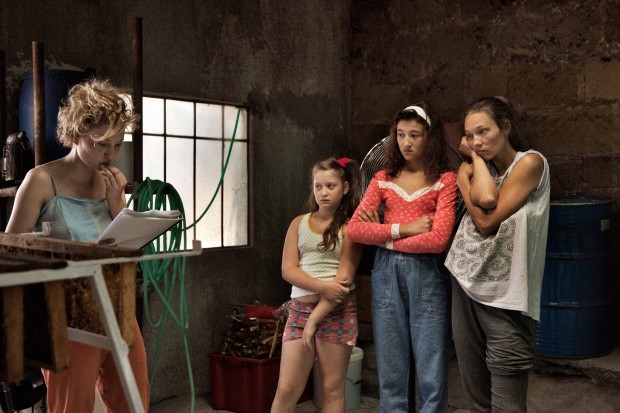
 Winner of the Grand Prix at the Cannes Film Festival, Alice Rohrwacher’s The Wonders is a sweet little gem of a movie, focusing on a German-Italian family that finds itself at a critical crossroads. Set in Rohrwacher’s (Corpo celeste) hometown in the countryside between Umbria-Lazio and Tuscany, the film follows the travails of a beekeeping family led by the gangly Wolfgang (Sam Louwyck), a grumpy ne’er-do-well from one of the Germanic countries who is trying to live some kind of back-to-the-land life away from authorities in an undeveloped backwater. His allegiance to old-fashioned tradition includes overworking his four young daughters while his wife, Angelica (Alba Rohrwacher, the director’s older sister), keeps at a distance and live-in friend Cocò (Sabine Timoteo) keeps stirring up the pot. At the center of it all is twelve-year-old Gelsomina (first-time actress Maria Alexandra Lungu, who was discovered in a catechism class), an exceptional beekeeper who wants her father to allow the family to participate in a television contest, Countryside Wonders, that could earn them much-needed money. But her father prefers taking care of things himself — though not very well, particularly when he acquires a camel for no apparent reason. Suspicious of the government and contemporary society, Wolfgang likes living in relative isolation; inviting strangers into their world could reveal the illegal working conditions, not to mention abuse of child labor laws. But Gelsomina is determined to improve their existence, starting with the competition, which is hosted by the beguiling, fairy-tale-like Milly Catena (Monica Bellucci in a marvelous white head piece, partially poking fun at her own sex-symbol image).
Winner of the Grand Prix at the Cannes Film Festival, Alice Rohrwacher’s The Wonders is a sweet little gem of a movie, focusing on a German-Italian family that finds itself at a critical crossroads. Set in Rohrwacher’s (Corpo celeste) hometown in the countryside between Umbria-Lazio and Tuscany, the film follows the travails of a beekeeping family led by the gangly Wolfgang (Sam Louwyck), a grumpy ne’er-do-well from one of the Germanic countries who is trying to live some kind of back-to-the-land life away from authorities in an undeveloped backwater. His allegiance to old-fashioned tradition includes overworking his four young daughters while his wife, Angelica (Alba Rohrwacher, the director’s older sister), keeps at a distance and live-in friend Cocò (Sabine Timoteo) keeps stirring up the pot. At the center of it all is twelve-year-old Gelsomina (first-time actress Maria Alexandra Lungu, who was discovered in a catechism class), an exceptional beekeeper who wants her father to allow the family to participate in a television contest, Countryside Wonders, that could earn them much-needed money. But her father prefers taking care of things himself — though not very well, particularly when he acquires a camel for no apparent reason. Suspicious of the government and contemporary society, Wolfgang likes living in relative isolation; inviting strangers into their world could reveal the illegal working conditions, not to mention abuse of child labor laws. But Gelsomina is determined to improve their existence, starting with the competition, which is hosted by the beguiling, fairy-tale-like Milly Catena (Monica Bellucci in a marvelous white head piece, partially poking fun at her own sex-symbol image).
 Shortly after meeting Ron “Stray Dog” Hall at the Biker Church in Branson, Missouri, writer-director Debra Granik (Down to the Bone) cast the Vietnam vet as Thump Milton in her second feature, the Oscar-nominated Winter’s Bone. Upon learning more about him, she soon decided that he would be a great subject for a documentary, so she took to the road, following him across the country in the engaging and revealing Stray Dog. Nearly always dressed in black, including his treasured leather jacket covered in medals and patches — when he puts it in a suitcase for a trip, it’s a ritual like he’s folding the American flag — Hall is a wonderfully grizzled old man with a fluffy white beard. At home, he is learning Spanish online so he can communicate better with his new wife, Alicia, a Mexican immigrant, and her two sons (who still live across the border). He visits with his teenage granddaughter, who is making some questionable decisions about her future. In Missouri, he owns and operates the At Ease RV Park, where he gives breaks to fellow vets who can’t always afford to pay the rent. And when he goes on the road, participating in the Run for the Wall, joining up with thousands of other bikers heading for the annual service at the Vietnam Veterans Memorial in Washington, DC, he stops along the way at other ceremonies honoring soldiers who have gone missing, are POWs, or were killed in action in Vietnam, Iraq, Afghanistan, and other wars.
Shortly after meeting Ron “Stray Dog” Hall at the Biker Church in Branson, Missouri, writer-director Debra Granik (Down to the Bone) cast the Vietnam vet as Thump Milton in her second feature, the Oscar-nominated Winter’s Bone. Upon learning more about him, she soon decided that he would be a great subject for a documentary, so she took to the road, following him across the country in the engaging and revealing Stray Dog. Nearly always dressed in black, including his treasured leather jacket covered in medals and patches — when he puts it in a suitcase for a trip, it’s a ritual like he’s folding the American flag — Hall is a wonderfully grizzled old man with a fluffy white beard. At home, he is learning Spanish online so he can communicate better with his new wife, Alicia, a Mexican immigrant, and her two sons (who still live across the border). He visits with his teenage granddaughter, who is making some questionable decisions about her future. In Missouri, he owns and operates the At Ease RV Park, where he gives breaks to fellow vets who can’t always afford to pay the rent. And when he goes on the road, participating in the Run for the Wall, joining up with thousands of other bikers heading for the annual service at the Vietnam Veterans Memorial in Washington, DC, he stops along the way at other ceremonies honoring soldiers who have gone missing, are POWs, or were killed in action in Vietnam, Iraq, Afghanistan, and other wars.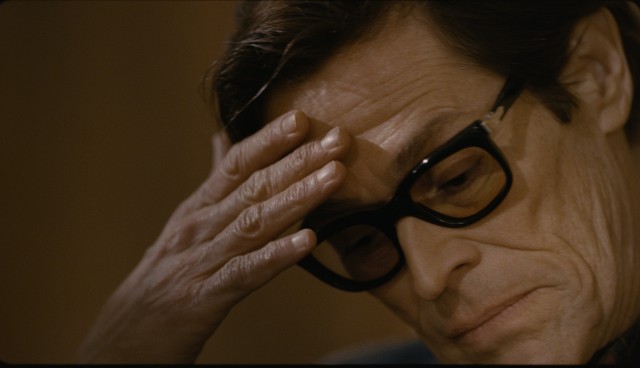
 Director Abel Ferrara packs a whole lot into controversial Italian writer and filmmaker Pier Paolo Pasolini’s last day on earth in the multinational coproduction Pasolini. Unfortunately, it all ends up a rather confusing jumble, with Ferrara (Bad Lieutenant, The Addiction) and screenwriter Maurizio Braucci (Gomorrah, Black Souls) squeezing too much into too little. Willem Dafoe stars as Pasolini on November 2, 1975, as the director is interviewed by a journalist, reads the newspaper on the couch, sits down at his typewriter to work on his novel Petrolio, edits what would be his final film (Salò, or the 120 Days of Sodom), and goes cruising to pick up a young stud. Ferrara adds enactments of scenes from the never-realized Porno-Teo-Kolossal, with Pasolini’s real-life lover, Ninetto Davoli, playing the fictional character Epifanio. (Davoli was supposed to play the younger Nunzio in the hallucinatory tale, about a search for faith and the messiah. Davoli is played by Riccardo Scamarcio in Ferrara’s film.) Ferrara never really delves into the internal makeup of Pasolini (The Gospel According to Matthew, Teorema), an openly gay outspoken social and political activist, poet, Marxist, Christian, and documentarian, instead using brief episodes that only touch the surface, as if Dafoe is playing a character based on Pasolini rather than the complex man who was indeed Pasolini. But Ferrara does get very specific about Pasolini’s mysterious, brutal death. Pasolini is screening October 2, 3, and 12 at the 52nd New York Film Festival.
Director Abel Ferrara packs a whole lot into controversial Italian writer and filmmaker Pier Paolo Pasolini’s last day on earth in the multinational coproduction Pasolini. Unfortunately, it all ends up a rather confusing jumble, with Ferrara (Bad Lieutenant, The Addiction) and screenwriter Maurizio Braucci (Gomorrah, Black Souls) squeezing too much into too little. Willem Dafoe stars as Pasolini on November 2, 1975, as the director is interviewed by a journalist, reads the newspaper on the couch, sits down at his typewriter to work on his novel Petrolio, edits what would be his final film (Salò, or the 120 Days of Sodom), and goes cruising to pick up a young stud. Ferrara adds enactments of scenes from the never-realized Porno-Teo-Kolossal, with Pasolini’s real-life lover, Ninetto Davoli, playing the fictional character Epifanio. (Davoli was supposed to play the younger Nunzio in the hallucinatory tale, about a search for faith and the messiah. Davoli is played by Riccardo Scamarcio in Ferrara’s film.) Ferrara never really delves into the internal makeup of Pasolini (The Gospel According to Matthew, Teorema), an openly gay outspoken social and political activist, poet, Marxist, Christian, and documentarian, instead using brief episodes that only touch the surface, as if Dafoe is playing a character based on Pasolini rather than the complex man who was indeed Pasolini. But Ferrara does get very specific about Pasolini’s mysterious, brutal death. Pasolini is screening October 2, 3, and 12 at the 52nd New York Film Festival.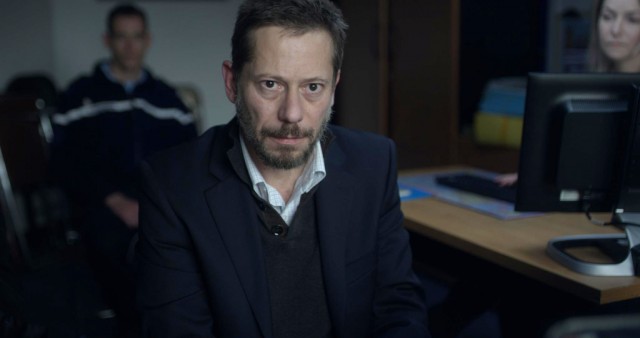
 Real-life partners Mathieu Amalric and Stéphanie Cléau strip Georges Simenon’s short 1955 novel The Blue Room to its bare essentials — and we do mean bare — in their intimate, claustrophobic modern noir adaptation, which makes its North American premiere at the New York Film Festival September 29 and 30. In addition to being one of the world’s most talented actors, starring in such films as Kings and Queen, The Diving Bell and the Butterfly, A Christmas Tale, and
Real-life partners Mathieu Amalric and Stéphanie Cléau strip Georges Simenon’s short 1955 novel The Blue Room to its bare essentials — and we do mean bare — in their intimate, claustrophobic modern noir adaptation, which makes its North American premiere at the New York Film Festival September 29 and 30. In addition to being one of the world’s most talented actors, starring in such films as Kings and Queen, The Diving Bell and the Butterfly, A Christmas Tale, and 